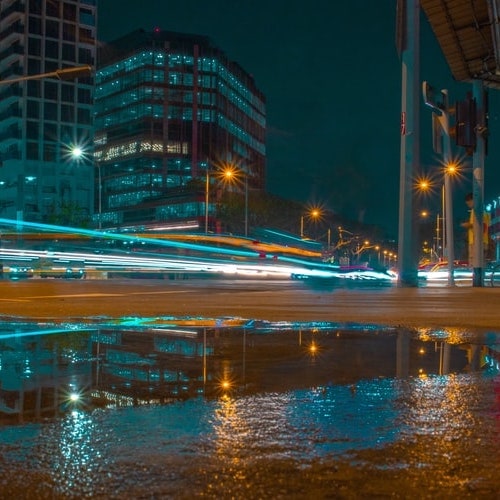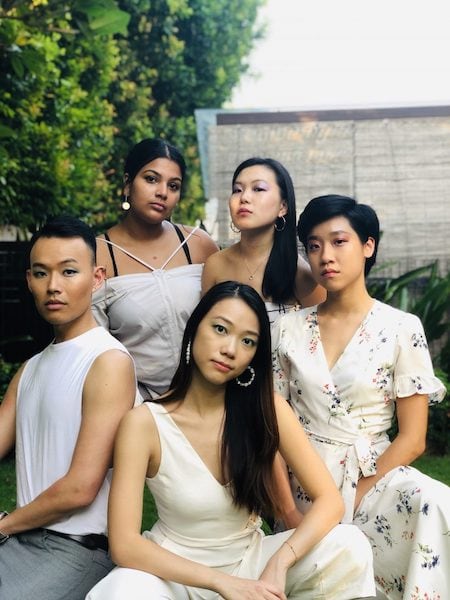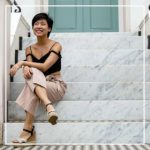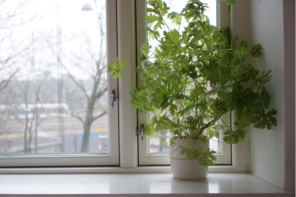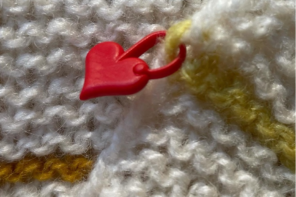Introduction
Wong Kwang Lin is an anthropologist and a dancer based in Singapore. K.L. Wong asked her colleagues and friends to create a collective choreography that brings together multiple interpretations of a theme. Through improvisation, the dancers interpreted the theme of the Fluid mosaic as an expression of passage and transit. In the choreography and video art, the question of transition emerges. Each dancer embodies the movement, as the elements float in the fluid barrier. Everyone exists autonomously while enacting and interacting with the other elements in a transitional space. Likewise, the body of the dancers and their gestures express a fluidity and the performative unrepeatability of movements that again allude to the dynamism and chaotic behavior of floating particles in biology. The rhythm of the montage expresses dreamlike scenes that exist between the sleeping and waking states, which link again with the liminality of the Fluid Mosaic. This liminality (Turner 1974) is preserved also between the collective improvisation and the montage, made by Alexander Lim, that purposefully maintained some ambiguity between the real and the surreal.
K.L. Wong and the team address the theme of the transit in both the macro- and the micro-perspective. The term transit includes the prefix trans, from the Latin word for across and through. One additional meaning of it is: to go beyond.
Under this value, the prefix trans is used in astronomy to denote something farther from the sun (Vourloumis and Andan. n.d.). It is under this last metaphoric signification that Wong’s project is situated. From a macro-perspective, the spaces where the choreography is performed are the airport, the subway, the bus. Her choreography aims to go beyond borders of individuality and disciplines while performing in spaces that cross the borders. All the spaces host ‘entities’ that are in transit and transit themselves as well. This directly recalls the behavior of particles in the fluid mosaic. The dancers use props that are transitory as strollers and luggage. On the micro-level, the bodies interact through dance as they were parts of cells that cooperate fluidly while maintaining their diversity.
The choreography proposed for this project looks like the embodiment of the process of transiting. As it happens in the membrane of the fluid mosaic, when the elements are enclosed, they interact speeding up their kinetic. This similar process can be seen in the choreography and its montage, where chopped rhythms and rapid movements highlight the dancers’ interconnection. The crisscrossing of the dancers’ legs, arms and bodies evokes again the biological crossing of the elements in the membrane as well. The overall work is structured as if all characters had their own fantasies that play out during the choreography. Some fall asleep and interpret the entire work as a flash back construction, for other it is a telenovela, others are playing at candy crush and then the dancers become part of the game as well embodying the balls’ movements; or again, the meeting and the goodbye of friends at the airport.
Reflections by WONG KWANG LIN
The choreography takes place in locations the anthropologist Marc Augé (1992) termed “non-lieux” (non-spaces). Did you think about that?
K.L.W. Definitely, that’s the book I’m reading on the train! I like the idea that in spaces where people are just meant to be passing through and not doing much, there could actually be a lot going on. Especially since most Singaporeans spend so much of our lives on public transport. Because apart from being non-places, the bus and MRT (Mass Rapid Transport) especially are also common places both in the sense that we use them almost every day, and are also meant to be accessible to the general public.
What about the choice of the music and the choreography?
K.L.W. The music is “All the Way” by Nova Materia (2017). We chose it for the complexity and variations in the rhythms, and also the dark or chaotic sense it evokes (at least for me, this feels like a contrast to how passive daily journeys seem to be).
All the movement was either improvised while filming, or choreographed right before filming the scene. In that sense, we didn’t intentionally see choreography and video montage as two different forms, but decided how to cut and edit after getting as much footage as we could.
What is the relation between the private and the public space?
K.L.W. People are always watching each other when little scenes of strangers’ lives play out on public transport, yet the transience of the moment means it can feel like such a private space even in a crowd. I don’t know if other people feel like there are times you’d just like to fall apart, but just need to trudge through the duties of the day first – but in these periods I love scheduling emotional breakdowns for long bus rides home, because that uninterrupted period is so ripe for overthinking. Sometimes there is a lot of moral panic around how atomized and uncaring people are getting in modern, urban life, but there can also be something comforting about the unspoken consensus to leave the strangers around you alone even if they’re weeping, or, for that matter, writhing all over the bus.
I sometimes feel quite uncomfortable in this city, like I’m always being watched or judged, whereas I remember one of my lecturers saying you could wear a banana costume down the streets of London and no one would bat an eyelid. But I have learned from other friends in Singapore that sometimes nonconformity, even audacity can be tolerated more than one would expect, I guess. Though I do imagine there’s a lot I could get away with by appearing to be a small, neurotypical Chinese girl (and therefore harmless).
Your video evokes the parallelism between goods and people, that as perpetual transient beings ‘transit’ in transitory -non spaces- as the malls and the airports etc. It seems to me, in order to make a connection with the theme, that your bodies are transient entities that ‘agglomerate’ in the action of transiting in a transitory space that exists just because of the transit itself.
K.L.W. I didn’t initially think of us as being perpetually transient beings, but that’s certainly a valid way of looking at it, and I do like that this position comes with such a sense of uncertainty and possibility at once. For me, there was an interesting tension between the transient, mobile nature of these places or vehicles, and the permanence that we nevertheless associate with their infrastructure. Singaporeans expect public transport to be running regularly (and get quite upset when it doesn’t!), and the mundane ritual of taking a bus or MRT is so significant in forming place-familiarity. When my train or bus goes past particular stops, I’m thinking – this is the door I have to stand at to get out right at foot of the escalator, or this is where I hung out every week after school, or where I used to harbor the tiny, absurd hope of bumping into someone because they’d have to change here to get downtown. It’s what makes the city endearing.
On a bigger scale, if we are to see ourselves as an agglomerated body, how are we meant to inhabit it?
Certain affordances arise from physical infrastructure and the built environment, not to mention explicit norms communicated through eager personalities or legal penalties. I recently read a reflection by my friend Alfonse Chiu that felt relevant: “[the street view] is democratic in the sense anyone can be there, but the true markers of civic freedom remain bracketed by the quotidian and ubiquitous presence of surveillance and self-censorship, which is a reason why incursions touching on public ownership of public spaces remain so neutered in states such as Singapore, where an official dogma goes unarticulated yet clearly understood—that public spaces are meant for transit, and rapid ones at that; anything else, get a permit.”
Each dancer is isolated and simultaneously united at times, in contact through body or gaze, but paradoxically autonomous from one another. They interact through movements with themselves and with the physical space they are dancing in. What do you think about this interpretation?
K.L.W. To go back to Augé, “Every day individuals borrow, so to speak, itineraries they have no choice but to follow, constrained by memories that are born of habit and that sometimes subvert it, brushing by, unaware of, but sometimes having an inkling of, the history of others, taking paths plotted with a collective memory turned trivial, whose efficacy is perceived only occasionally and at a distance”(Augé 2002: 25) So yes, your ideas of transitory space and isolation/unity at once are very relevant! We probably think of ourselves as separate individuals, yet we incorporate strangers in our daydreams, recognize familiar commuters who take the same routes every day, etc…
As an anthropologist and a dancer, what is your relation between these two disciplines for this project?
K.L.W. I didn’t think very intentionally about ‘bridging’ the two but I do think they’re fairly prone to seeping in and out of each other in some ways. In both areas, I enjoy looking at affective and embodied experiences on what might be considered a small or mundane scale, and dance helps me to clarify and process ideas that I can’t quite make sense of with thoughts and disinterested reasoning alone. The dancer Nancy Stark Smith has this concept of an “idiot button” to reset your mind while dancing, but dance itself often functions as that button for me in a broader context, and reminds me to focus on what human experience feels and how people relate to each other, beyond theories and data. Like any other kind of art, I guess – and anthropologists sometimes talk about ethnography as a kind of art or involving elements or artistry, because this effectively brings across sensory or emotional states that are analytically significant.
The Team
Wong Kwang Lin, Alexander Lim, Kailing Neo, Jeslyn Soh, Niranjana Krishna, An Luong, and Priya Narayan.
References
Augé, Marc. 1992. Non-lieux. Introduction à une anthropologie de la surmodernité. Paris: Seuil.
Turner, Victor. 1974. “Liminal to liminoid in play, flow, and ritual: An essay in comparative symbology”. Rice University Studies 60 (3): 53–92.
Vourloumis, Hypatia and Mirwan Andan. N.d. intraACTION transCOLONIALISM. DAI Roaming Academy. https://dutchartinstitute.eu/page/8640/hypatia-vourloumis-and-mirwan-andan-intraaction-transcolonialism-introduction
Featured image by Ian Yeo (courtesy of Unsplash.com).

